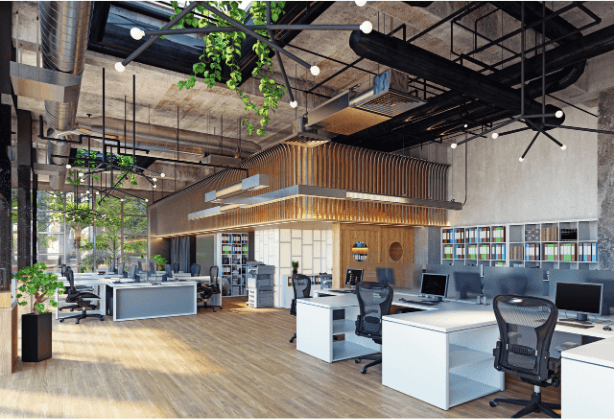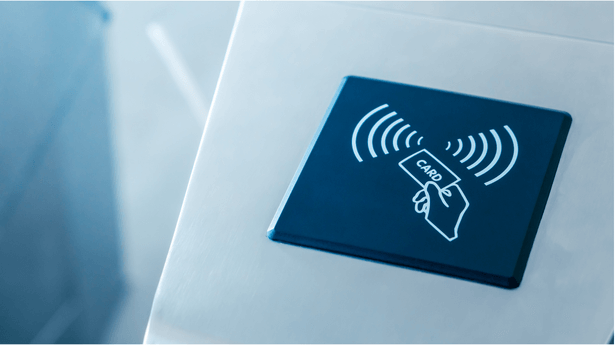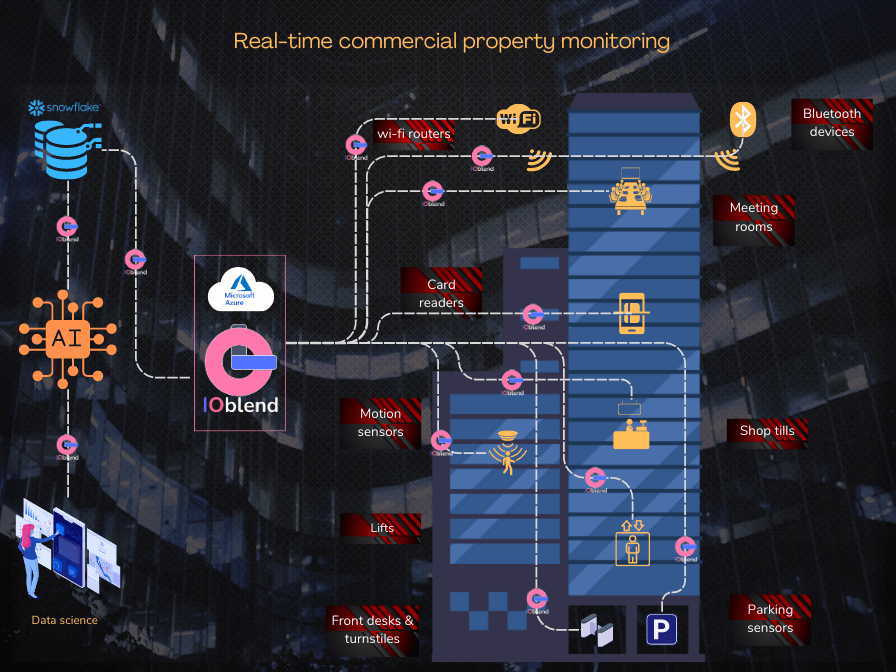Commercial property
Welcome to the next issue of our real-time analytics blog. This time we are taking a detour from the aviation analytics to the world of commercial property management. The topic arose from a use case we are working on now at IOblend. It just shows how broad a scope is for real-time data applications pretty much everywhere we look.
Commercial property covers everything, from offices, to shops, to warehouses, etc. Government buildings, airports, hotels, amusement parks – they all fall into this category of property or real estate. These properties have one essential feature in common: they act as focal points for people to perform work, particularly office buildings.

Post-pandemic changes
Offices generally see a lot of use, so they require constant management to keep the buildings and facilities fit for purpose, cater for the workers’ needs and comply with health and safety regulations. Ground rents and upkeep are expensive, so property managers also need to maximise occupancy rates to be financially viable.
COVID 19 has changed the way we work (perhaps forever), so we no longer use the office space as much as we used to. Companies downsize their offices, meaning they require less space, thus reducing the rents they pay. Property managers then face under-utilised buildings, diminishing rent income and high maintenance costs (you still need to do upkeep). They needed to get smarter and more creative to lure people back into the buildings, which is now leading towards new interior designs, healthier food options, more co-working spaces, etc.
But how would you know what measures make a material difference?
As you may have correctly guessed it, data is used extensively by large property management companies to inform their operations. They use multiple data feeds such as lease agreements, utility bills, maintenance records, catering/shops sales, parking stats, front desk registry and turnstiles, meeting room bookings, surveys, etc. They collate and analyse this data manually to derive general trends and financial forecasts. The analysis is always static and only shows a limited picture.
But how would you know what measures make a material difference?
- Once inside, what do the tenants do besides occupying their desks?
- What areas do they visit and at what times?
- Do they go anywhere aside from using the restrooms and kitchens in their respective areas?
- How do they split their time between the desks, break-out areas, social spaces, and meeting rooms?
- Are there any consistently under-utilised spaces that could be converted to different purposes?
- If we invest in more attractive facilities, will they bring more customers?
It is challenging from a technical perspective to track what is happening inside the building at any given time, especially considering the privacy aspect – we, humans, do not like being constantly scrutinised by an unseen eye.

So here lies the challenge:
Property management companies want an ability to monitor activity inside the buildings in real-time but at the same time they must preserve privacy and remain unintrusive to the workers. Oh, and the system must not cost a fortune to build and maintain.
We have recently started to collaborate to bring one such capability to reality. While some solutions on the market today provide information about the building usage, they tend to analyse data from static data sources. IOblend connects to any source that produces data and processes it in-memory, performing multiple complex transformations in real-time cost-effectively. We process data in real-time in the customer’s cloud infra (MS Azure here).
In this case the project involves live entries from the front desks, turnstile scans, lift panels, meeting room reservations systems, wi-fi routers, motion sensors, Bluetooth devices, shop tills, parking sensors and internal card readers. Any personal data gets anonymised before we stream it to the warehouse (they use Snowflake).
A custom analytics suite then maps this data onto a virtual layout of the building and produces a visual representation of the interior activity, allowing property managers to analyse how the building is being used at any given time.
It’s early days still, but the insights from just one office already identified poorly utilised spaces and overcrowded areas (and the underlying causes), showed people flows by time of day across the entire building, and highlighted a potential to easily save energy. Interestingly, the project is not dissimilar to the one we described earlier for airport passenger tracking.

The next phase is to integrate an AI model to start introducing predictive maintenance capabilities. In parallel, they are also experimenting with the LLM to dynamically run comparisons with other properties in their portfolio and general market. Very exciting times for real-time data indeed.
If you are considering real-time analytics capabilities for your commercial property portfolios, get in touch today and let us show you the art of the possible.
Resolving the complexities of managing offices with real-time data, as opposed to common methods, involves a transformative approach that IOblend offers. Traditional property management relies on static data sources like lease agreements and utility bills, which only provide a limited view. IOblend, on the other hand, utilizes real-time data from diverse sources like front desk entries, turnstile scans, and sensor data, processed cost-effectively in the cloud. This approach allows property managers to gain instantaneous insights into space utilization, people flow, and energy consumption, enabling more informed decision-making. By mapping this data onto a virtual layout of buildings, IOblend not only enhances operational efficiency but also respects privacy concerns, a vital aspect in today’s data-driven world.

Data Syncing: The Evolution Of Data Integration
Data syncing, a crucial aspect of modern data management. It ensures data remains consistent and up-to-date across various sources, applications, and devices.

How IOblend Enables Real-Time Analytics of IoT Data
The real power of IoT lies in the data it generates in real-time. This data is continuously analysed to derive meaningful insights, mainly by automated systems.

Data Plumbing Essentials: Production Pipelines
The creation of production data pipelines is an exercise in precision engineering, meticulous planning, robust construction, and continuous maintenance.

Breaking Down the Walls: Overcoming Data Silos
All enterprise data should be discoverable, catalogued and made available for analytics. But the reality is quite different. Data silos are a persistent issue.

Complex World of Enterprise Data Estates
Large enterprises data estates are complex and costly to run and maintain. IOblend enables simplified data integration capabilities that alleviates complexities
Advanced data integration solutions: IOblend vs Pentaho
IOblend and Hitachi Pentaho are advanced data integration tools catering to the data needs of businesses. They differ in architecture design, features and cost.

